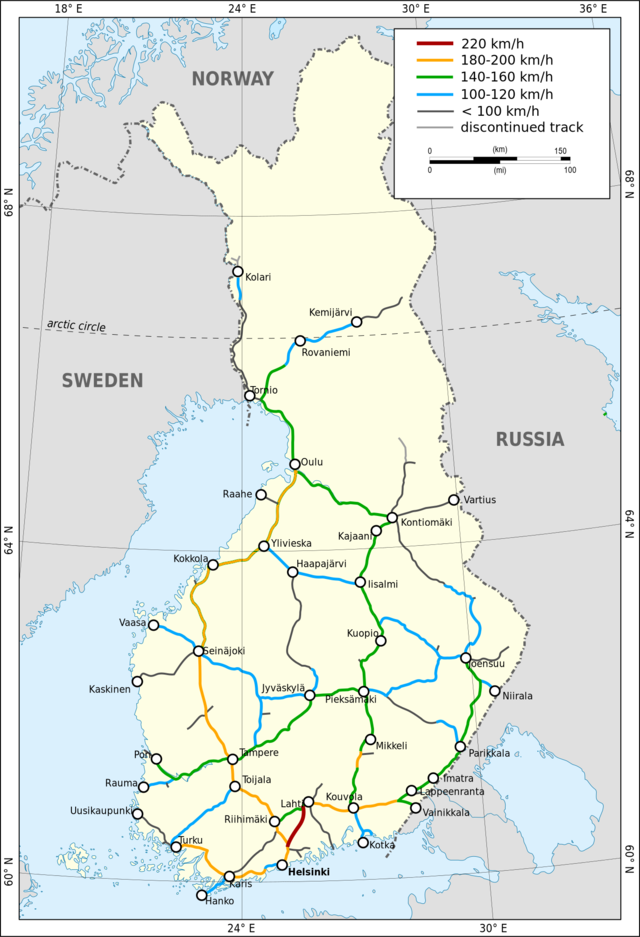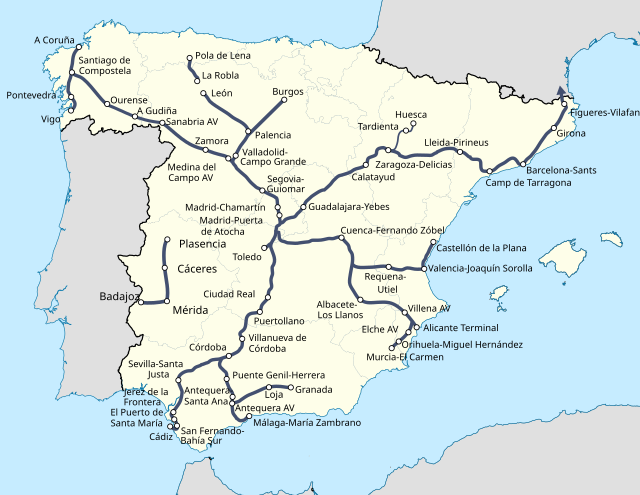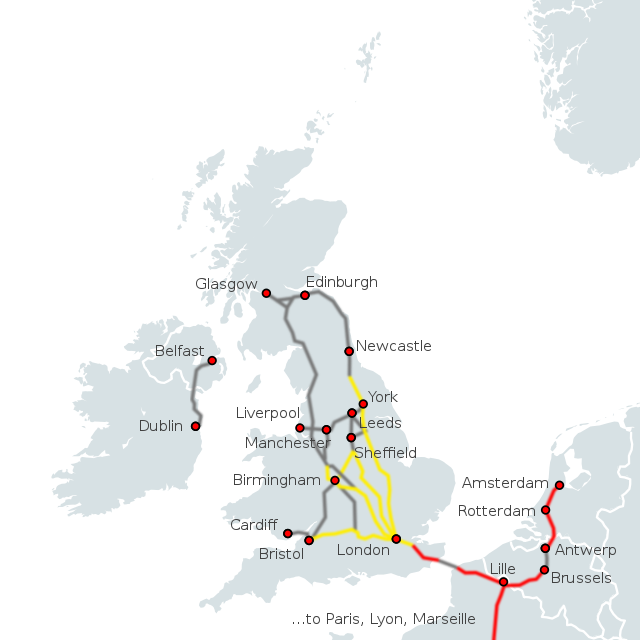Top Qs
Timeline
Chat
Perspective
List of high-speed railway lines
From Wikipedia, the free encyclopedia
Remove ads
This article provides a list of operational and under construction high-speed rail networks, listed by country or region. While the International Union of Railways defines high-speed rail as public transport by rail at speeds of at least 200 km/h (124 mph) for upgraded tracks and 250 km/h (155 mph) or faster for new tracks, this article lists all the systems and lines that support speeds over 200 km/h (120 mph) regardless of their statuses of upgraded or newly built.[1][2]

Remove ads
Overview
Summarize
Perspective
Operational networks
The following table is an overview of high-speed rail in service and under construction by country. It shows all the high speed lines (speed of 200 km/h (125 mph) or over) in service. The list is based on UIC figures (International Union of Railways),[3][4] updated with other sources.[5]
Operational length in km:
- China: 48,000 (64.6%)
- Spain: 3,973 (5.34%)
- France: 3,516 (4.73%)
- Germany: 3,348 (4.50%)
- Japan: 3,066 (4.12%)
- Sweden: 1,711 (2.30%)
- South Korea: 1,548 (2.08%)
- United Kingdom: 1,485 (2.00%)
- Italy: 1,312 (1.77%)
- Others: 6,375 (8.58%)
By region
Operational length in km:
- Asia: 55,206 (74.5%)
- Europe: 18,547 (25.0%)
- Africa: 186 (0.25%)
- North America: 136 (0.18%)
Freight services
Networks under construction
Remove ads
Africa
Algeria
Egypt
Morocco
Remove ads
Asia
China

India
Indonesia
Japan

Saudi Arabia
South Korea

Taiwan
Thailand
Turkey
Uzbekistan
Vietman
Remove ads
Europe
Austria
Baltic States (Estonia, Latvia and Lithuania)
Belgium
Czech Republic
Denmark
Finland

France

Germany

New lines, 300 km/h (186 mph)
New and upgraded lines, 250–280 km/h (155–174 mph)
Upgraded lines, 200–230 km/h (124–143 mph)
Conventional lines (selected), 160 km/h (100 mph)
Greece
Italy

Netherlands
Norway
Poland
Portugal
Russia
Serbia
Spain

Sweden

Switzerland
Turkey
United Kingdom

140–186 mph (225–300 km/h)
125 mph (200 km/h)
<110 mph (180 km/h)
Remove ads
North America
Canada
United States
Remove ads
See also
Notes
- Population data is based on worldometers.info, as of July 2024
- Diabolo project+Line 50A
- at stations
- Rolling stock is ready to be used on 1520 mm network abroad.
- 574.8 km/h record; 300 km/h first exceeded in 1950s
- 1,5 kV DC or 3 kV DC at some upgraded lines
- gas turbine and propeller tested
- as dedicated line; conventional exceeded 200 km/h in late 1960s
- P.A.Th.E./P. sections supporting at least 200km/h are summed here.
- Tōhoku Shinkansen to be increased to 360 km/h in around 2027; unconventional lines under construction are expected to be faster.
- 1435+1067 dual gauge in the Seikan tunnel
- Eurostar (international) trains only, local high-speed trains (V250) failed to launch (250 km/h). 200 km/h trains started operation April 2023 (ICNG trains).
- upgraded lines and stations only
- HSL-Zuid only
- Linha do Norte (116.2 out of 336 km) + Linha do Sul (107 out of 274 km)
- Diesel above 200 km/h tested
- Diesel push-pull trains also capable for 200 km/h, but limited to 180 km/h
- 310 in 2007-2016; 330 km/h designed
- wide-gauge and upgraded lines only
- Diesel or bi-mode on some of upgraded lines
- gauge-change trains in use; wide-gauge is limited 220-250 km/h
- Sincan–Köseköy (313km) + Polatlı–Konya (212) + Kayaş–Sivas (394km) + Konya-Karaman (102km)
- Eurostar (international) trains only. 330 km/h after completion of (HS2). The East Coast Main Line will be increased from 200 to 225 km/h after re-signaling.
- 750V DC Third-Rail at junctions only. Diesel is widely used despite ongoing electrification
- 275.198 km of CHSR IOS Merced-Sacramento; 351 km of LA-LV Brightline West and 30 km of Newark-Trenton under upgradation to 260 km/h
- 12.5 kV 60 Hz AC (New Haven–New York),
12 kV 25 Hz AC (New York–Washington),
25 kV 60 Hz AC (Boston–New Haven) - gas-turbine and steam tested
- only 7,206.7 km without China
- only 6,563.91 km without China
- 13,770.61 km without China
- Exception: 1530 in Uzbekistan.
- Excluding Turkey which is counted in Asian section.
- 25 kV 50 Hz AC (most common, for most of lines electrified in recent years),
15 kV 16.7 Hz AC (second most common, especially in German-speaking and Scandinavian countries),
3 kV DC,
1.5 kV DC,
diesel (especially in the UK) - Exception: 1520 in Russia; 1524 in Finland; 1668 in Spain and Portugal
- 25 kV 50 Hz AC (most common, for most of lines electrified in recent years),
15 kV 16.7 Hz AC (second most common, especially in German-speaking and Scandinavian countries),
3 kV DC,
1.5 kV DC - Exception: 1668 in Spain and Portugal
- 12.5 kV 60 Hz AC (New Haven–New York),
12 kV 25 Hz AC (New York–Washington),
25 kV 60 Hz AC (Boston–New Haven) - 7,700+ km with long-term plans by 2050s
- upgraded lines only
- no later than 2030
- no later than 2030
- Part of the greater Beijing-Hong Kong, Macau corridor.
- Part of the coastal corridor; consists of the Hangzhou-Fuzhou section which is already operational and is listed separately above
- Tianjin-Yantai and Nantong-Suzhou sections under construction
- Guangzhou-Hepu section is under construction
- 812 km under construction
- Including Yinchuan-Xi'an line and Hainan Eastern and Western ring railway lines.
- 1,422 km is under construction; ~950 km is planned
- 646 km is under construction
- Proposed branch to Taipei crossing Taiwan Starit.
- 690 km under planning; 409 km under construction
- 2,965 km under construction
- Including a branch line to Chongqinq.
- Xiong'an-Xinzhou (340 km) and Chongqing-Kunming (698.98 km), totalling 1038.96 km is under construction
- ~1,000 km under planning.
- Max speed attained on record: 603 km/h
- out of 331.3
- 5.2 extra added in 2016
- Nangang station
- Bangkok–Nakhon Ratchasima
- out of 312.2 total
- Tallinn-Pärnu
- Lithuanian section
- Latvian section
- Danish side
- Karis – Paimio stretch, out of 195.8 km total
- out of 357.8 km total
- out of 188 km total
- Lahti-Luumäki
- Luumäki-Vainikkala
- Le Capitole service before 1990s, TGV since 1990s
- south
- north
- out of 622 km total
- triple border between France, Germany and Switzerland
- no earlier than 1992 when electrified
- first 300 km
- rest 106 km
- 280 km/h if delayed.
- 280 km/h if delayed; 300 km/h upgradable
- out of 240 km total
- 230 km/h after 2025 planned
- most of the line - 250 km/h; 300 km/h upgradable
- partly opened in 1969
- out of 116 km total
- out of 116 km total
- planned
- out of 600+ km total
- out of 267 km total
- out of 267 km total
- out of 204 km total
- 67 km of the section is operational while the rest of it is under construction.
- out of 96 km total
- Line is 200 km/h ready but as of 2024, there are no trainsets operating beyond 140-160 km/h on this route.
- excludung 17 km ready in 2015
- Hamar-Brumunddal
- Brumunddal-Lillehammer
- constructed with geometrically allowed 250 km/h option already
- Warsaw–Lodz; extra 310 km beyond in next phase
- 310 km/h previously; 330 km/h designed
- including 24.6 km in France
- final section suspended
- out of 483
- out of 390
- out of 290
- out of 150
- first 50 km
- out of 58 km total
- No trains operate above 200 km/h
- For tilting trains; rest of the passenger trains operate at 200 km/h
- 230 km/h in case of delay; 250 km/h designed speed
- 230 km/h in case of delay; 250 km/h designed speed
- out of 116.5 km total
- English section only; the Welsh is slower
- out of 632.7 km total
- 225 km/h in case of delay
- out of 642 km total
- international services only, domestic are limited 225 km/h
- international services only, domestic are limited 225 km/h
- out of 500 km total
- straight sections only, 90-110 mph at curves
- 360 km/h by other sources
- While the Northeast Corridor spans 735 kms, only 80.3 km of its section support 240 km/h speeds. Several stretches of track on the Northeast Corridor can support up to 201 km/h speeds, but those speeds are the international standard definition of high-speed rail for upgraded tracks, and also are considered higher-speed rail by FRA standards.
- The 56.3 km stretch between Orlando and Cocoa which supports 200 km/h is newly built.
- Temporarily only between Merced and Bakersfield
- The IOS (Initial Operating Segment) will be 171 miles, while the completed Phase 1 route will be 494 miles long. Currently, the completed system, which includes Phase 2 (includes Sacramento and San Diego), will be 776 miles long. Phase 2 has yet to begin construction.
- with existing portions between San Francisco-Gilroy at phase 1 and LA and Anaheim at phase 2
- possibly 110 mp/h at phase 2 in LA-Anaheim upgraded segment
- not at full length, full network would take another 5-10 years
- The Brightline West will run to the Rancho Cucamonga station in Greater Los Angeles in Southern California, where riders can use the Metrolink San Bernardino Line to connect to Union Station.
Remove ads
References
Wikiwand - on
Seamless Wikipedia browsing. On steroids.
Remove ads
